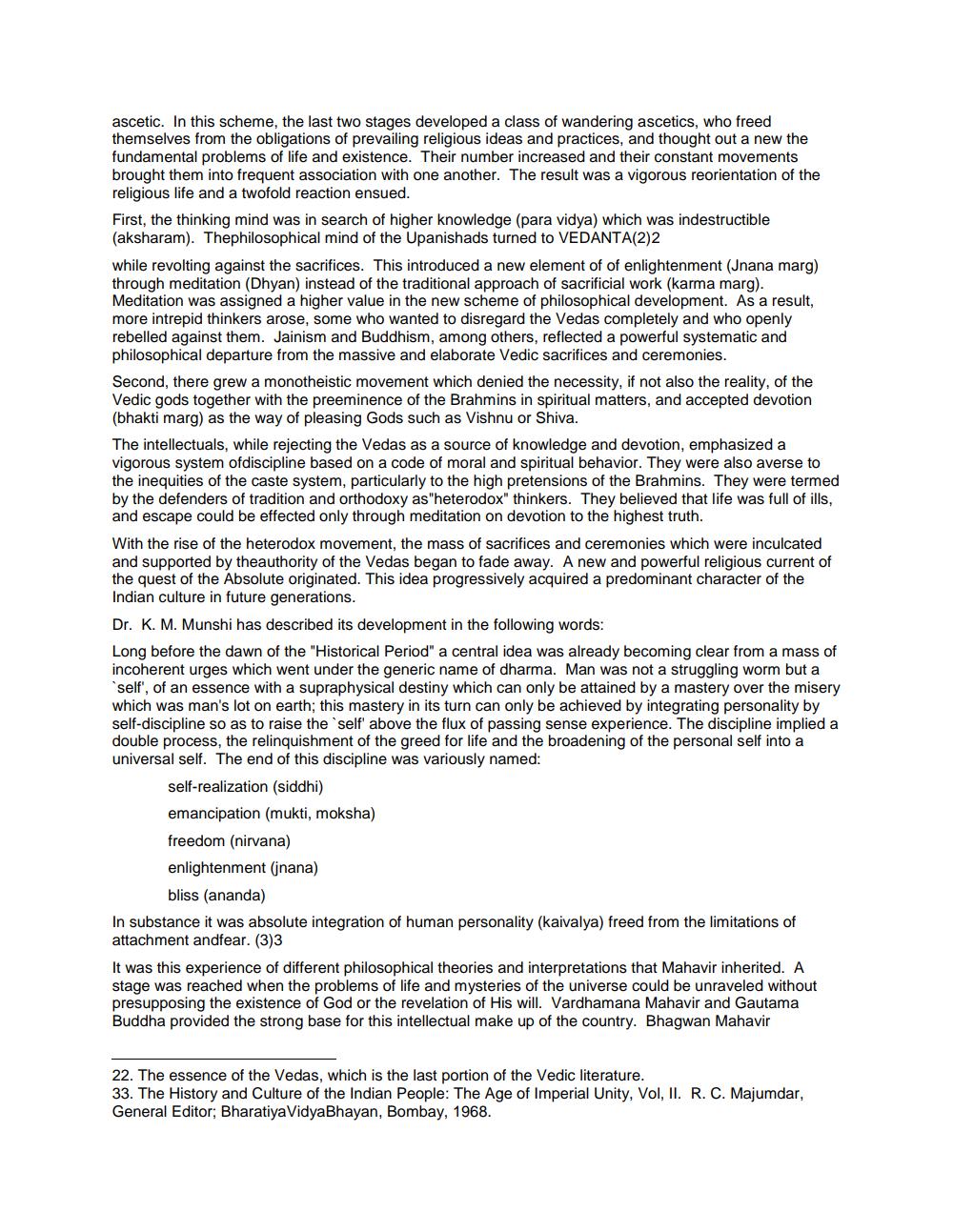________________
ascetic. In this scheme, the last two stages developed a class of wandering ascetics, who freed themselves from the obligations of prevailing religious ideas and practices, and thought out a new the fundamental problems of life and existence. Their number increased and their constant movements brought them into frequent association with one another. The result was a vigorous reorientation of the religious life and a twofold reaction ensued. First, the thinking mind was in search of higher knowledge (para vidya) which was indestructible (aksharam). Thephilosophical mind of the Upanishads turned to VEDANTA(2)2 while revolting against the sacrifices. This introduced a new element of of enlightenment (Jnana marg) through meditation (Dhyan) instead of the traditional approach of sacrificial work (karma marg). Meditation was assigned a higher value in the new scheme of philosophical development. As a result, more intrepid thinkers arose, some who wanted to disregard the Vedas completely and who openly rebelled against them. Jainism and Buddhism, among others, reflected a powerful systematic and philosophical departure from the massive and elaborate Vedic sacrifices and ceremonies. Second, there grew a monotheistic movement which denied the necessity, if not also the reality, of the Vedic gods together with the preeminence of the Brahmins in spiritual matters, and accepted devotion (bhakti marg) as the way of pleasing Gods such as Vishnu or Shiva. The intellectuals, while rejecting the Vedas as a source of knowledge and devotion, emphasized a vigorous system ofdiscipline based on a code of moral and spiritual behavior. They were also averse to the inequities of the caste system, particularly to the high pretensions of the Brahmins. They were termed by the defenders of tradition and orthodoxy as "heterodox" thinkers. They believed that life was full of ills, and escape could be effected only through meditation on devotion to the highest truth. With the rise of the heterodox movement, the mass of sacrifices and ceremonies which were inculcated and supported by theauthority of the Vedas began to fade away. A new and powerful religious current of the quest of the Absolute originated. This idea progressively acquired a predominant character of the Indian culture in future generations. Dr. K. M. Munshi has described its development in the following words: Long before the dawn of the "Historical Period" a central idea was already becoming clear from a mass of incoherent urges which went under the generic name of dharma. Man was not a struggling worm but a self', of an essence with a supraphysical destiny which can only be attained by a mastery over the misery which was man's lot on earth; this mastery in its turn can only be achieved by integrating personality by self-discipline so as to raise the self above the flux of passing sense experience. The discipline implied a double process, the relinquishment of the greed for life and the broadening of the personal self into a universal self. The end of this discipline was variously named:
self-realization (siddhi) emancipation (mukti, moksha) freedom (nirvana) enlightenment (jnana)
bliss (ananda) In substance it was absolute integration of human personality (kaivalya) freed from the limitations of attachment andfear. (3)3 It was this experience of different philosophical theories and interpretations that Mahavir inherited. A stage was reached when the problems of life and mysteries of the universe could be unraveled without presupposing the existence of God or the revelation of His will. Vardhamana Mahavir and Gautama Buddha provided the strong base for this intellectual make up of the country. Bhagwan Mahavir
22. The essence of the Vedas, which is the last portion of the Vedic literature. 33. The History and Culture of the Indian People: The Age of Imperial Unity, Vol. II. R. C. Majumdar, General Editor; Bharatiya Vidya Bhayan, Bombay, 1968.




